Lance Greenfield's Blog, page 25
September 1, 2019
Book Review: The Perfect Murder by Peter James
 The Perfect Murder by Peter James
The Perfect Murder by Peter James
My rating: 4 of 5 stars
A married couple, Victor and Joan, have grown apart over the years. They have become bored with each other and have sought, and found, extra-marital stimuli. Each plans to murder the other so that they can begin new lives with their respective lovers. The planning is meticulous. It has to be to fall in line with the book’s title, The Perfect Murder.
The big question, right from the very beginning, is who will succeed in murdering the other first? Or will the murders be so perfect that they occur simultaneously.
To find out the answer to that question, and many others that this story raises, you’ll just have to invest an hour of your time to read it.
Psychogeography and Folklore: Walking the City’s Legends
Original post: Psychogeography and Folklore: Walking the City’s Legends by Icy Sedgewick
I really enjoyed listening to Icy Sedgewick telling the story of psychogeography. I recommend that you do this. It is so much better to listen to her than to read the article, although that is also a good experience.
It reminded me of when I was a child and my Mum used to take us for a ride in her mini which was called Zebedee. We’d make a plan, such as first right first left, second right, second, left, third right, third left, then start again with first right.
Eventually, we’d get stuck down a dead end or get fed up with the driving. We’d get out of the car and go for a random walk. We would discover new countryside and return with a small plant or a stone or a piece of driftwood or some other souvenir of our adventure. We would experience something new and unexpected and often spiritual.
I suppose, in a way, we were unintentional psychogeographers. Then again, perhaps not.
A few weeks ago, we headed to Manchester to explore a story related to Dr John Dee. In that post, I mentioned a tale involving a group of psychogeographers and their attempts to contact the good doctor’s spirit. I asked if anyone wanted a post about psychogeography as a practice. People said yes, so here it is!
We’re going to be walking the city in this post. So put on your most comfy boots, pack a drink and a snack, and let’s explore this fascinating way to encounter the landscape and it’s folklore…
Click on the link below to listen to the post. Or keep reading!
Listen to Psychogeography and Folklore: Walking the City’s Legends by Icy Sedgewick.
What is psychogeography?
It’s not the easiest of terms to define. Over the years, it’s taken on a whole range of meanings. Academics describe it one way, practitioners another. Some of you reading this will probably disagree with the way I describe it. If you do, just remember there is no one way to practice it.
The term ‘psychogeography’ can be traced back to 1950s Paris (Coverley 2010: 10). Guy Debord, part of the Situationist movement, tried to make it a legitimate term. In essence, it describes the point where psychology and geography meet. It’s “a means of exploring the behavioural impact of urban place” (Coverley 2010: 10).
 Graffiti spotted in Florence. Graffiti is a great way to judge a place’s impact on people © Icy Sedgwick
Graffiti spotted in Florence. Graffiti is a great way to judge a place’s impact on people © Icy SedgwickIn other words, psychogeographers look at how people behave based on the space around them. And yes, there is a link with folklore. We’ll get to that.
Chris Rose further explains the focus on emotion, and that there is “an emphasis upon walking, paying critical attention to the (generally but not exclusively) urban landscape and the power structures that have shaped it” (2016). The “paying attention” bit is key here.
Will Self notes that “[s]ome see psychogeography as concerned with the personality of place itself” while others pursue “minutely detailed, multi-level examinations of select locales” (2013). So some psychogeographers might focus on a whole area in a city. Others pick a specific location and do more of a cross-section of it.
Earlier Origins
Many look back to the flâneur of 19th century Paris for the true origins of psychogeography. Charles Baudelaire coined the term to describe men who observed the city as they strolled around it. They were usually intellectuals and independently wealthy, so they had the leisure time to do this.
 A good example of the flâneur in action! Paris Street: Rainy Day by Gustave Caillebotte [Public domain]
A good example of the flâneur in action! Paris Street: Rainy Day by Gustave Caillebotte [Public domain]The surrealists also got involved. Their practice of automatic writing turned into a form of walking. You simply walked governed by where you were ‘led’ to walk by your unconscious.
But this is barely scratching the surface. There’s no specific ‘method’ for doing psychogeography. Different people practice it in different ways. And for very different reasons.
Tina Richardson points out that “urban walking” has a whole range of things to look out for (2015). These walkers might explore spaces as they appear during the day compared to the way they appear at night. Or during different weather conditions.
I don’t want to go into the different theoretical approaches. Or even the history, because there are books like Merlin Coverley’s title that cover this in depth.
What we’re going to talk about is how you do it and how it ties in to folklore.
So how do you actually DO psychogeography?
First, you walk. You do not drive. Rose explains this is because walking gives you the chance to look, think and explore (2016). You’re not just going for a nice stroll. Psychogeographers actively pay attention to the world around them. But they also have their stroll without planning a route or even having a destination in mind.
So you might decide you’re going to explore part of your hometown. I’m in Newcastle so I might decide to leave the dim confines of the Metro system at the Haymarket station. I choose a direction to leave the station, then simply walk.
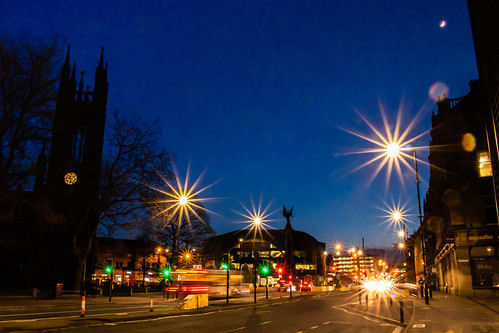 Looking towards the Haymarket in Newcastle. © Icy Sedgwick
Looking towards the Haymarket in Newcastle. © Icy SedgwickWhile walking, I pay attention to what’s around me. I might make notes, or I might take photographs. I might even choose to focus on a specific thing, like the signs I see on the way.
You might just get on the first bus outside your house. Count fifteen stops and get off. Then start walking.
Or just go to Venice and try to find your hotel without using Google Maps. Good luck.
Basically, however you want to do it is right. Tina Richardson explains that “[i]t is the psychogeographer who makes psychogeography happen” (2015).
So far, I’ve focused on the subject in terms of its urban heritage. Coverley notes in the introduction of the 2018 re-issue of his 2006 book on the topic that psychogeography was once preoccupied with towns and cities (2018). London, in particular, became overly studied. By the time of the re-issue, this urban focus “has been eclipsed by a growing preoccupation with the ‘wild places’ of the natural world” (2018).
Because nature writing is nothing new, Coverley tends instead towards the “indistinct borderlands” at the edge of the urban landscape. Neither rural nor urban, they attract psychogeographers precisely because they’re neither one thing nor the other.
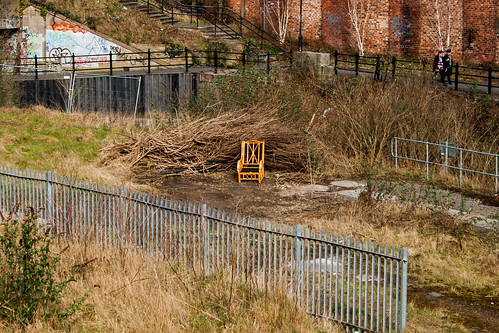 The Ouseburn district of Newcastle is neither in the city centre, nor suburban © Icy Sedgwick
The Ouseburn district of Newcastle is neither in the city centre, nor suburban © Icy SedgwickIn an interesting twist, many ghost stories crop up in these ‘in between’ places. In the field of Gothic Studies, they’re known as ‘liminal spaces’. Sunrise or sunset are liminal times because they’re on the cusp of two distinct states. Places can do the same thing.
How does psychogeography link with folklore?
Because of the intense focus on a small area, psychogeography can tip into local history. The psychogeographer either knows what was there before and looks for signs. Or they see the signs first and work backwards to research what they mean.
The deep penetration into an urban area’s past uncovers its legends, superstitions, and quirks. All of which pop up in its folklore.
Rose makes a lot of connections between psychogeography and psychotherapy. In particular, “What is said is linked to where it is said” (2016). Here, psychotherapy explores the impact of the environment on a person. Which isn’t so different from psychogeography. And, incidentally, folklore.
Now this is just personal opinion. But space and place are both so important to folklore. Granted, the same stories often emerge in different locations. Look at Jenny Greenteeth, appearing in a host of ponds and rivers around the UK. Or countless Grey Lady ghosts, often with the same backstory but haunting different spaces.
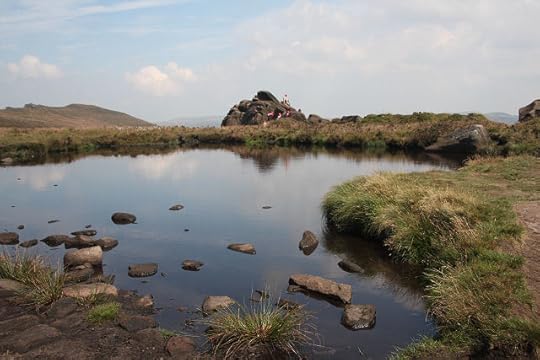 An image of Doxey Pool by Bob Jones, said to be home to Jenny Greenteeth [CC BY-SA 2.0]
An image of Doxey Pool by Bob Jones, said to be home to Jenny Greenteeth [CC BY-SA 2.0]But then there are the deeply specific stories. The legends so intrinsically tied to place that you can’t go there without being aware of the links. Why are selkie stories so tied to the North Sea lands? What is it about these places that makes the stories appear here?
As Rose points out, “it becomes even clearer that not only who we are is profoundly shaped by place, but that place involves power” (2016). By doing psychogeography, we become aware of place and power in equal measure. And the folklore is often tied to both.
It’s all about place.
You can’t do psychogeography without looking at the idea of place. That’s why it has ‘geography’ in the name. And it’s the folklore or legends that often make a place special.
Or is there more to it than that? The Romans believed in the genius loci, or the spirit of a place. For the Romans, it was a protective spirit tied to the area. Is the practice of psychogeography an unconscious attempt to encounter this genius loci?
For Linda Lappin, a more modern version of the genius loci “is a composite of climate and landscape [held] together with the cultural markings in a site left by its current residents and those of long ago” (: xi). Look at the brick heart of Venice. Add that to the marks left by its current inhabitants. Combine the two to get a sense of the genius loci of Venice.
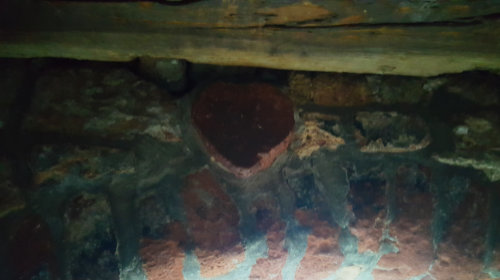 The brick heart! © Icy Sedgwick
The brick heart! © Icy SedgwickIncidentally, the flâneur first emerged in Paris during a period of urbanisation. The city landscape changed to incorporate new forms of shopping, transport, and architecture. The observation of the city coincided with a period of rapid change. These new symbols of ‘modernism’ swept away older legends and superstitions, uncovering these stories in the process.
To give you an example, John Clark notes the existence of a so-called medieval phrase associated with the London Stone (2010: 38). According to the myth, this stone must remain in the city, otherwise it will fall.
So long as the Stone of Brutus is safe,
So long will London flourish
(Clark 2010: 38)
It’s even quoted by Peter Ackroyd, Jennifer Westwood and Jacqueline Simpson. Yet Clark notes it only dates to 1862 (2010: 38). Either way, it inextricably links this piece of stone with the founding myths of London. A place in the City draws its power from a chunk of rock associated with folklore.
 The London Stone by GrindtXX [CC BY-SA 4.0 (https://creativecommons.org/licenses/by-sa/4.0)%5D
The London Stone by GrindtXX [CC BY-SA 4.0 (https://creativecommons.org/licenses/by-sa/4.0)%5DThis in itself is the crossover between the fields. You have these places that have some sense of power, and there’s usually a legend or superstition associated with them. By doing psychogeography, you expose the folklore.
And then there are the links with the occult.
Thanks to Alan Moore’s From Hell, many people showed renewed interest in particular sites around London. Here, occult history emerges out of the urban landscape through signs and symbols most people would ignore.
But not psychogeographers. Their intense focus on an area leads them to pay more attention. Architectural foibles take on new significance.
The Bohemian Blog even refers to From Hell as “a study not of stones, but rather a very personal exploration of the meanings etched into them”. Their comprehensive blog post follows the routes on the map between significant locations in the graphic novel. Seeing them in this light helps draw new connections between the sites.
 The Ten Bells pub, beloved by Jack the Ripper and Shoreditch hipsters alike © Icy Sedgwick
The Ten Bells pub, beloved by Jack the Ripper and Shoreditch hipsters alike © Icy SedgwickThe Value of Psychogeography for Folklore
Remember, all ‘occult’ means is hidden. This is really the key to linking psychogeography with folklore. It’s a means of teasing the hidden back into plain view. We can uncover these lost stories and forgotten legends. And maybe breathe life back into the old figures that once walked these streets beside us.
So next time you’ve got a spare half hour, give it a go. Walk somewhere familiar with fresh eyes. Or choose somewhere unfamiliar, armed with curiosity (and your smartphone, sadly safety is still your priority). And let me know what you find!
Have you done psychogeography? Will you give it a go? Let me know below!

References
Clark, John (2010), ‘London Stone: Stone of Brutus or Fetish Stone – Making the Myth’, Folklore, 121:1, pp. 38-60.
Coverley, Merlin (2010), Psychogeography, Harpenden: Pocket Essentials.
Coverley, Merlin (2018), Psychogeography, third edition, London: Oldcastle Books.
Lappin, Linda (2015), The Soul of Place: A Creative Writing Workbook, Palo Alto: Solas House.
Richardson, Tina (2015), Walking Inside Out: Contemporary British Psychogeography, London: Rowman & Littlefield.
Rose, Chris (2016), Walking together: psychogeography and psychotherapy, sketching, psychotherapy and beyond. Accessed 28 August 2019.
Self, Will (2013), Psychogeography, London: Bloomsbury.
August 25, 2019
Book Review: Premonitions by Daniela I Norris
 Premonitions by Daniela I. Norris
Premonitions by Daniela I. Norris
My rating: 4 of 5 stars
Have you ever experienced that incredible feeling of déjà vu?
Of course you have! Everyone in the world has experienced it at least once. You are walking through a place that you have never been to before and you know exactly what is around the next corner before you take the turn. How did that make you feel? Bemused? Confused? Determined to work out why it happened? At the very least, it is rather unnerving.
The way that I deal with it is just to accept it without fully understanding it. Nevertheless, it is still somewhat unnerving.
Premonitions continues to develop the life stories of the three main characters from Recognitions: Amelia of twenty-first century New York, Adele of eighteenth century France and a shaman from a remote village in West Africa in the fifteenth century. The connectedness of the people in the lives of those three characters also becomes stronger, particularly in the way that Amelia’s friend, Noah, starts to discover his reluctant connection with eighteenth century France. He has never been to France in his life.
Amelia becomes more and more curious and feels compelled to investigate the visons that appear to her in her dreams.
The intertwined stories are intriguing and the reader is drawn along by an irresistible desire to read on. I won’t say any more about the story lines for fear of spoiling it for you, but I will warn you that Adele’s story is left hanging two days short of the known date of the storming of the Bastille, the defining event of the French Revolution.
Skilfully done, Daniela I. Norris! How would it be possible for readers of the first two books in this trilogy to deny themselves the pleasure of reading the third, Precognitions, which is due to be published in 2020?
August 23, 2019
The Jungle Awakes
I am sitting in a hot, humid jungle clearing. I can feel the damp earth against my skin. Rivulets of sweat run down my chest and my belly. My forearms rest on the insides of my knees, my hands up-turned to give and to receive. With my eyes closed, I hear life all around me. The birds hopping and scurrying around in the branches, calling to each other. The howler monkeys, imitating the wind blowing through the highest branches. Many other, unidentifiable noises reach my ears, adding to the orchestrated harmony of the forest.
[image error]
Photo by mauro arrue on Unsplash
My tummy churns, heat rising into my chest. The warmth calms me.
Your fragrance infuses the space around me. I feel the gentle, apricot vibrations of your aura as you approach.
I hear the swish of your satin robe as it slides off your shoulders and settles on the jungle floor. I choose to keep my eyes closed, turning up the volume and the enjoyment value on all of my other senses.
Delicious. Wonderful. Beautiful.
You sit between my legs, placing your legs over mine.
You edge, shuffle, towards me until our bodies almost touch. I feel your heat.
We pause. Our roots descent into the earth beneath us. We draw on the sap of the Earth’s energy. It rises into our cores and then forms a spherical furnace in the small gap between our bodies. The energetic sphere rotates and grows, permeating our bodies with colour and sound and heat. We drift together, drawn by a force much greater than ourselves, until only a thin layer of perspiration separates our bodies.
The Earth trembles beneath us as the sphere develops into a tornado rising high into the sky, through the clouds and out into space. The energy travels far and fast until, like the flux of a magnetic field, it comes back through the Earth and enters our merged bodies through our red roots.
August 21, 2019
The Bond
[image error]So right and yet so wrong
is that incredible bond.
It is so very strong.
Do you feel it?
As we hug,
crown connected to crown,
heart to heart,
core to core,
root to root.
Do you feel it?
Our spiritual serpents entwine.
Earthquakes and tsunamis resonate
in perfect harmony,
deep chords underpinning our melody.
We sit on our hill,
legs overlapping.
Naked bookends,
drawing Mother Earth’s sap
up through our roots
and into our cores.
The tornado builds between us,
bridging the short gap
then joining our bodies
in our eternal bond,
unbreakably strong.
Do you feel it?
So right yet so wrong:
our unbreakable bond.
Our energy rises
through the atmosphere and stratosphere,
across the boundless cosmosphere
in a great, returning curve.
Much later, those beautifully scented, musical colours
flow through us and around us
as we sit together, lie together,
binding us together
in our unbreakable bond.
Do you feel it?
So right and not so wrong,
our eternal bond
is so very strong.
Ghost Tour: Edinburgh #Vaults #Greyfriarsbobby
Edinburgh is a fascinating, historic city.
The true story of Greyfriars Bobby captured me during my childhood. .
Take this tour and be prepared to travel in time through Scotland’s capital
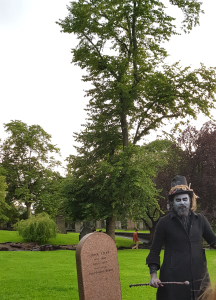
I’ve always wanted to go on a Ghost Tour in Edinburgh and this time I did.
Just before we left there was a spell of thunder and lightning and I was beginning to wonder just how dramatic our night out was going to be!
One of the stops on the tour was Greyfriars Cemetary – I imagined us standing there by the grave stone tombs whilst thunder and lighting missed us by inches. Luckily, the crazy weather subsided just before we went. But, we nearly didn’t make it in time. The buses were ridiculously busy due to the Edinburgh Festival and we arrived at the designated tour spot just as the tour was about to set off!
Our tour guide was appropriately dressed, regaling us about the beheadings, macabre happenings, cannibals and ghosts of Edinburgh.
He also entertained us with the celebrated tale of Greyfriars Bobby, a terrier of much…
View original post 300 more words
August 5, 2019
Book Review: Recognitions by Daniela I Norris
 Recognitions by Daniela I. Norris
Recognitions by Daniela I. Norris
My rating: 4 of 5 stars
Here we have three intertwined stories. The paths through time and space are interconnected.
Daily, we tread the here-and-now road. We can make decisions as to how we interact with the road and with everything and everybody else on that road. Occasionally, other roads intersect our own. We can observe those who travel down those roads, and connect with them, but we have little influence on their direction. But could they influence our own direction?
Amelia is an American editor, working in Manhattan. As she struggles to cope with bringing up her two children following the breakup of her marriage, she resorts to trying hypnotherapy. This leads her to connections with Adele, an eighteen year-old living in pre-revolution, south-eastern France, and a shaman living in an African riverside village which is in danger from Portuguese slave-traders.
Her life is further complicated by a chance meeting with an old school classmate from her own teen years in San Francisco: a fourth strand to the story.
As the book concludes, Amelia comes close to bringing the four strands together and providing a semblance of clarity. There is still a long way to go and I can’t wait to find out what happens in the second book in the trilogy, Premonitions, which was published in June 2019.
Note: This book means a lot to me. It was the last book that my Dad ‘read’ before he departed from this life. In fact, it was read to him by myself, my sister and my step-mum. Reading the whole book to fill in the chapters that I’d missed as I read to him, made me feel whole. Furthermore, he was with me all the time that I was reading Recognitions.
August 2, 2019
Words to Make You Think
Here’s a very interesting article from the Society for Editors and Proofreaders (SfEP) which I picked up from LinkedIn.
It commences with:
What do you think of when you read the words ‘inclusion’ or ‘diversity’?
[image error]
Image credit: SfEP
Did you know that, ironically, the word ‘inclusion’ originally meant to shut someone in as a form of imprisonment or that the heart of the word ‘diversity’ means to turn in different directions?
View the original article from Susie Dent, honorary vice-president of the SfEP here: https://blog.sfep.org.uk/inclusion-diversity/
At the end of the article, you are encouraged to give feedback on what comes into your mind when you think of these words: ‘inclusion’ and ‘diversity.’
My reaction was to come up with another word that may inspire you to think. What does the word ‘sanity’ mean to you. Please leave your comments below and, perhaps, suggest more words to make people think.
July 28, 2019
Book Review: The Longhand Option by Dinesh Allirajah
 The Longhand Option by Dinesh Allirajah
The Longhand Option by Dinesh Allirajah
My rating: 4 of 5 stars
It is unlikely that robots will ever replace the entire complexity of human beings but we are seeing rapid progress in the automaton technology to replace humans for some tasks such as mowing the lawn and driving cars and trains. The inventiveness of humans both drives and limits the ways in which we can use these technologies.
The late Dinesh Allirajah collaborated with Professor Francesco Mondada to produce this story about a futuristic family and some of their innovative uses of technologies. The robots are just part of every day life for the people of the age, but Nat invents a new virtual reality world for his grandmother, Rosa, to explore, which helps her with her writing.
I really enjoyed the story and I marvelled at the creativity of the author.
Two memories came into my mind as I read it.
The first was the game of ‘inventions’ that my father, a nutty but brainy professor, introduced me to almost as soon as I could walk and talk. He got me to think of something that I would really like in my life which did not yet exist. Then he would ask me to imagine that the concept was already reality. What would I desire as the next stage? He would throw in his own suggestions to improve upon mine. By the time we’d gone through five or six iterations, we would have leapt decades or even centuries, into the future. Strangely, some of those inventions are now reality. Shame we never patented them.
The second was an encounter that I had with Jaron Lanier, the founding father of virtual reality, when I worked at Computer Associates in the mid-nineties. He was a keynote speaker at CA-World in New Orleans. Jaron showed us his weird and wonderful musical world of virtual instruments as he sat on the stage playing them with Zimmerman’s data glove. He then told us about how he had used virtual reality to help skilled surgeons share live feeds of their real micro-surgery with medical students around the globe. That was amazing! His final show was a virtual kitchen that could be created by the customers of his client, a Japanese company, to design and create their dream kitchen using, colours, positioning of storage and appliances even to the extent of how it would feel to use the kitchen. Fascinating!
This short story is equally amazing and fascinating. I really enjoyed it.
July 25, 2019
Book Review: Folktales and Legends by Adalbert Stifter
 Folktales and Legends by Adalbert Stifter
Folktales and Legends by Adalbert Stifter
My rating: 3 of 5 stars
This is a delightful collection of folk tales. Although translated into English from the original German, the translator has managed to retain the authentic atmosphere of the old-fashioned language. One can just imagine a Bohemian grandfather sitting in a candle-lit cottage parlour, telling these tales to the children as they sit, open-mouthed on the floor in front of the fire.
They carry the mystery of magical figures, of Christian and pagan beliefs as they would have existed a century or two ago.
The trees and streams and rocks and caves all bear their own secrets.
Although I didn’t feel the terror that I sometimes experienced as my mother read the fairy tales of the brothers Grimm to me more than five decades ago, there were some slightly scary scenes. There were also some very enchanting stories.
I enjoyed the collection and the connections between some of the stories and I would recommend them to you if you can get your hands on a copy. I bought this book in a shop in Wenceslas Square in Prague. That makes it even more special to me.




